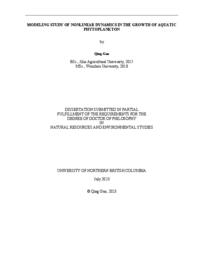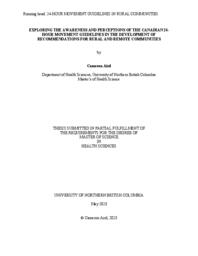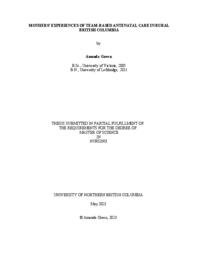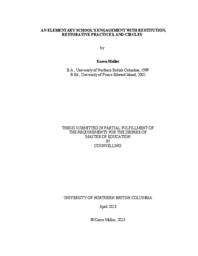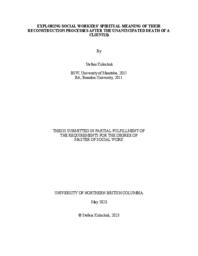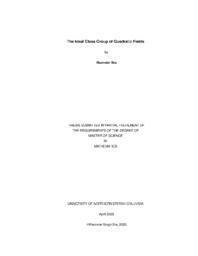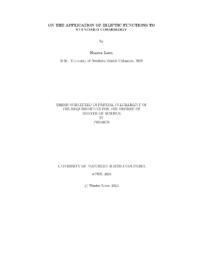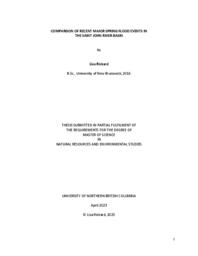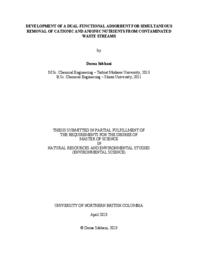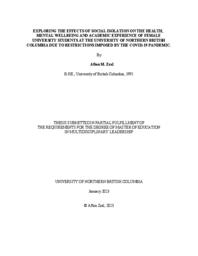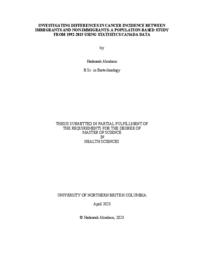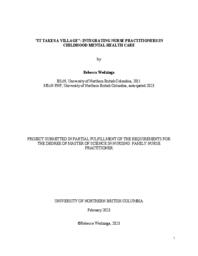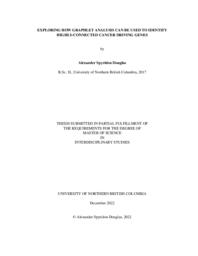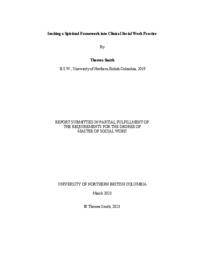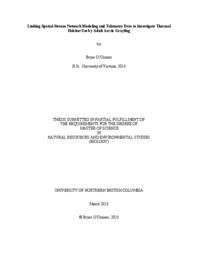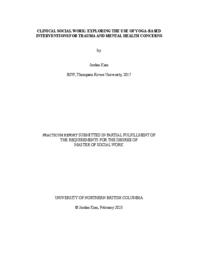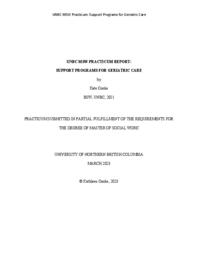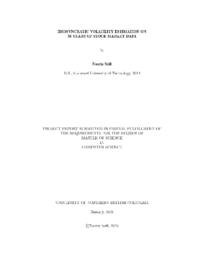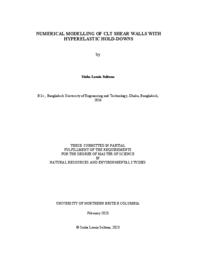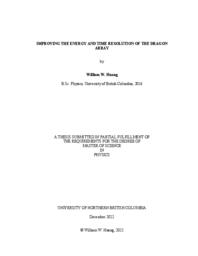University of Northern British Columbia
Related Works
Content type
Digital Document
Description / Synopsis
Phytoplankton bloom has become a growing global concern in recent years due to the excessive growth of algae, causing significant negative impacts on aquatic ecosystem and threatening human health. Growing evidence suggests that algal blooms are a consequence of the interplay of various hydrodynamical, chemical, and biological processes in aquatic systems. The complexity and nonlinearity of aquatic ecosystems, and the complexity of climatic and hydrographic events, make interpreting and predicting the blooms a very challenging task. In recent years, many different strategies have been adopted to manage algal blooms. Among them, mathematical models are advantageous because they can capture the ubiquitous stoichiometric constraints for modeling species growth and interaction. Thus, mathematical models have been widely used to investigate the dynamics of phytoplankton growth. In this study, five mathematical models were developed based on population dynamics, ecological dynamics, dynamic modeling, and probability theory. The models were investigated theoretically and numerically in terms of the theory of partial differential equations, stochastic differential equations, impulsive differential equations, and numerical simulation. The objective of this dissertation research was to gain insight into plankton dynamics and explore potential management strategies for excessive algal growth in aquatic systems. The main results are presented as follows: Firstly, a nutrient-plankton model incorporating delay and diffusion was developed. The theoretical analysis revealed that delay can trigger the nutrient-plankton oscillation via a Hopf bifurcation. Especially, the stability switches for positive equilibrium occur with increasing delay, which indicates that delay can generate and suppress the unstable coexistence of species population. Numerical results reveal that the stability switches for positive equilibrium indeed exist in the model, and the homogeneous multiple periodic solutions, as well as chaos, can occur with different values of delay, which implies that the model exhibits delay-induced complex dynamics. Secondly, a stochastic Leslie-Gower phytoplankton-zooplankton model with prey refuge was developed. The dynamical analysis revealed the sufficient conditions for the persistence and extinction of plankton populations. The numerical simulations showed that environmental noise and prey refuge play a crucial role in the survival of plankton species. The results further demonstrate that prey refuge can enhance the oscillation range of phytoplankton population, but the variance of zooplankton tends to increase and then decrease as prey refuge increased. Thirdly, considering seasonal disturbances in aquatic ecosystem, a stochastic nutrient-phytoplankton model with seasonal fluctuation was developed. The results indicate that periodic solutions exist under certain conditions, suggesting that plankton populations are associated with periodic oscillations. Furthermore, numerical results showed that seasonal fluctuation can trigger periodic blooms of phytoplankton and promote the coexistence of plankton species. Specifically, the results indicate that phytoplankton is more sensitive to nutrient than to seasonal fluctuation. Fourthly, a stochastic nutrient-plankton model with regime-switching was developed by considering regime-switching plankton mortality. The results showed that the model admits a stationary distribution under certain conditions. Then the numerical analysis revealed that the persistence and extinction of plankton populations are sensitive to variations in nutrient input. The numerical results also indicate that regime-switching plankton mortality contributes to the survival of plankton populations in the aquatic system. Finally, a stochastic nutrient-plankton model with impulsive control was developed. The theoretical analysis established sufficient conditions for the existence of periodic solutions. In addition, the numerical analysis showed that nutrient impulse plays an important role in preventing and controlling algal blooms, and appropriate environmental fluctuation can promote the coexistence of phytoplankton and zooplankton populations. However, excess intensity noise can result in the collapse of the entire ecosystem.
Origin Information
Content type
Digital Document
Description / Synopsis
The Canadian population is aging, and rates of obesity are also on the rise. These demographic changes have implications for the long-term care (LTC) system in Canada that need to be better understood, yet little is known about the population with obesity in Canadian LTC. In this thesis, an exploratory analysis of residents newly entering LTC between 2010 and 2020 is provided. Cross-tabulations and chi-squared statistical testing (p≤0.001) were employed to analyze retroactive, consecutive cross-sectional initial assessment data (N=350,348) from the Canadian Institute for Health Information’s (CIHI) Community Care Reporting System (CCRS) to explore the levels of obesity, demographic characteristics (age, sex, primary language, rural or urban previous residency), rates of health conditions, and independence and assistance levels of activities of daily living (ADLs). Over the full study period, the rate of obesity for the population entering LTC was 19%, and 7% entered with at least class II obesity (≥35 kg/m2). Rates of obesity and BMI obesity categories tended to increase incrementally over the course of the study period. Those entering LTC with obesity were more likely to be younger, female, English/French speaking, and arriving from rural areas. Individuals with obesity had lower rates of dementia and higher levels of independence when performing ADLs. They also exhibited higher rates of diabetes and a greater need for two+ person assistance for ADLs. This thesis begins to fill in the gap in our understanding of the population with obesity in LTC, providing a broad picture of the heterogeneous nature of the population, including important differences in health and ADL profiles across the three obesity BMI categories (i.e., classes I-III).
Origin Information
Content type
Digital Document
Description / Synopsis
The present study evaluated the awareness and knowledge of the Canadian 24-Hour Movement Guidelines in rural and remote communities, and explored how to adapt guideline communication material to improve their impact and relevance. People living in rural and remote communities completed a cross-sectional survey (N = 76) and individual interviews (N = 12) to explore what is known about the guidelines and provide recommendations to help adapt the materials to local context. Overall, most participants were aware of the guidelines (44.7%) and had moderate knowledge of recommendations and dosages (64.5%). Deductive thematic analysis was used to code the barriers and facilitators to meeting guideline recommendations and map them onto the Behaviour Change Wheel. Recommendations for adapting the guidelines were created which included: providing additional information on being active outdoors and at home, information discerning sedentary behaviour and inactivity, and tips to combat seasonal changes in daylight.
Origin Information
Content type
Digital Document
Description / Synopsis
Introduction: The health care system in British Columbia places priority on providing teambased primary maternity care. Participation of mothers in planning their care is an essential component of team-based care. Therefore, it is important to understand mothers’ experiences of team-based maternity care. Background: An integrated literature review resulted in 12 articles focused on mothers’ experiences with antenatal care delivered by a team of providers. Evidence highlighted the positive impact of team-based speciality antenatal care. Mother’s experiences of community team-based antenatal care were a notable gap in the literature. Objective: To explore antenatal care experiences of mothers living in rural British Columbia, where team-based antenatal care is known to exist. Method: To understand the perceptions of mothers' experiences of team-based antenatal care a qualitative methodology was used. An interpretive description approach combined semi-structured interviews with eight mothers purposively selected from two rural communities. Findings: Mothers played a key role in shaping the continuity of their care. Mothers collaborated with their providers across three types of continuity expressed within a team-based antenatal care context: management, informational, and relational. Building the relationship between the mother and a consistent provider (relational continuity) required clinical coordination (management continuity) and clear communication (informational continuity). From the mother's perspective, a specific team composition did not rate as highly as the connection to a consistent provider with whom they had respectful and trusting relationship. For all eight mothers a nurse and physician team-combination promoted continuity and patient-centeredness. Specifically, a primary care maternity nurse role supported stability in the mother's antenatal care. Gaps in continuity arose from experiences of antenatal care during the Covid-19 global pandemic and in the mothers’ mental wellness and pelvic floor health. Conclusion: When the mothers shared responsibility for continuity in care this strengthened the mother-provider partnership, regardless of which discipline was providing care. Mothers appreciated the continuity of carer – a provider who could develop a relationship with them during their antenatal care. The mothers valued providers who worked as part of a network, collaborating with a range of interdisciplinary providers to support the mothers’ antenatal care needs. Clinical Implications: There is merit in expanding discussions on the value a consistent provider working alongside mothers in rural team-based primary maternity care brings to mothers’ experiences of and engagement with antenatal care. Future research on how both continuity of care and continuity of a carer can support sustainable team-based antenatal care to improve outcomes is warranted in all community contexts.
Origin Information
Content type
Digital Document
Description / Synopsis
After over 100 years of operation, the Norman Wells Oilfield located in the Northwest Territories is beginning the process of closure and reclamation. In negotiating the Sahtú Dene and Métis Comprehensive Land Claim Agreement (1994), Sahtú people have gained more power over environmental decision-making, including directing the goals and outcomes of reclamation projects. A case study approach was used to collect qualitative data over 8 weeks in Fort Good Hope, Northwest Territories and 3 days in Norman Wells, Northwest Territories. Data were collected through 41 semi-structured interviews using open-ended questions with Sahtú people and key informants and an analysis of past engagement records to examine the structures and processes for how Sahtú Dene and Métis have been engaged in the Norman Wells Oilfield project throughout history, and identify opportunities for their meaningful involvement in remediation, reclamation, and monitoring in the future. Findings reveal that past engagement and consultation from Imperial Oil with the Sahtú people has been culturally inappropriate. This has resulted in a loss of trust, violation of Dene principles of reciprocity, and overall ineffective communication. These research findings are intended to contribute to the conversation about the Norman Wells Oilfield closure and reclamation, as well as broader discussions on Indigenous peoples' involvement in environmental reclamation after resource extraction.
Origin Information
Content type
Digital Document
Description / Synopsis
Wildfires are a growing threat due to climate change, and they often leave unburned forest patches called fire refugia. While young forests in some regions burn more severely, preliminary observations in central British Columbia suggest that managed juvenile forests exhibit lower fire severity, potentially influenced by fuel moisture conditions, and stand characteristics. To identify the role of fuel moisture in the formation of juvenile stand fire refugia, this research collects and examines groundbased, empirically modelled, and remote sensing indices of greenness, moisture, and fire severity. This thesis investigates the fuel moisture contents (FMC) of duff, fine woody debris, and foliage at six locations near Prince George and Smithers, British Columbia (BC), over two summers (2021 and 2022). A total of 6116 individual samples of foliage, fine woody debris, and duff were collected from open, juvenile, and mature conifer forest stands and analysed for moisture content (MC). On average, the MC of duff and fine woody debris samples was higher in juvenile and mature forests than open sites. In contrast, open forests had higher foliage MC than the other forests. Observations of FMC were used to evaluate the accuracy of FMC estimates extracted from the Canadian Forest Fire Weather Index (FWI) system. Observations of FMC were also compared with remote sensing indices to assess the utility of using spaceborne (Landsat 8&9, Sentinel 2) remote sensing to predict local FMC. Three versions of the FWI model were used to estimate FMC: the original FWI model which uses the closest fire weather station, and versions that used updated parameters based on local fuel conditions and in-stand weather data. When estimating fine woody debris MC, the best statistical results are obtained with locally calibrated models at open stands. However, the original FWI model provides better estimates of duff MC in juvenile stands. For remote sensing of foliar MC in juvenile stands, the Normalized Difference Moisture Index (NDMI) had a higher R2 value (0.334) and a lower RMSE than other indices, while the NDMI gave the best result for foliar MC in mature forests (R2 = 0.160). For fine woody debris and duff MC in open stands, none of the remote sensing indices tested have R2 > 0.1 when estimating duff and fine woody debris MC. However, the RMSE of using empirical models from FWI to estimate duff (lowest at 59.95% RMSE) and fine woody debris (21.13%) MC was higher than remote sensing (41.64% for duff, 17.50% for fine woody debris). Remote sensing indices such as NDMI and GNDVI (Green Normalized Difference Vegetation Index) were used to estimate pre-burn FMC, and the estimated FMC results were found to be generally higher at juvenile stands than mature forest from a case study area from Plateau Complex Wildfire of 2017. Lower remote sensing estimates of FMC in mature stands corresponded to higher burn severities.
Origin Information
Content type
Digital Document
Description / Synopsis
Canadian schools have long employed punitive discipline, a colonial paradigm that is hierarchical and exclusionary. Using Participatory Action Research, two Indigenous and nine non-Indigenous educators collaborated to implement a restorative model into an elementary school in northern British Columbia. Our hybrid of Restitution and Restorative Practices (RRP) and Circles included regional Indigenous protocols. A thematic analysis of participant interviews revealed patterns in the key areas of belonging, cultural safety, trauma informed practice, shame, and decolonizing education. RRP was experienced as an egalitarian model and Indigenous protocols supported community building during Circle practice. Implementation of RRP and Circles (RRP/C) did not represent enough structural change to decolonize discipline, but this hybrid was a relational and holistic model that integrated the Indigenous values of consensus building, interconnection, and harmony. Concerns with the model and its implementation included cultural racism, resistance, vulnerability, shame, and safety.
Origin Information
Content type
Digital Document
Description / Synopsis
Background: This interpretive qualitative inquiry explores the spiritual meaning of their reconstruction processes of social workers after the unanticipated death of a client. Identifying existing social networks and using snowball sampling, ten social workers in British Columbia were recruited for this research. From a socially constructed and spiritual perspective, the researcher examines this process in collaboration with the ten participants. Through semistructured interviews the social work participants gave deep and rich personal stories reflecting on the experience of having a client unexpectedly die. Through a process of thematic analysis, four main themes, and nine sub-themes emerged from the data. Objective: To explore and gain a better understanding of social workers’ experiences of unanticipated client death and the spiritual meaning of their reconstruction processes after this experience. Methods: An interpretive qualitative inquiry was used for this study. A literature review was conducted to identity existing research and any gaps in research on the thesis question. Subsequently, semi-structured interviews were conducted with ten social worker participants who shared their experiences of unanticipated client death and spiritual meaning of their reconstruction processes. Thematic analysis of the data, guided by Braun and Clark (2018) was undertaken. Results: Three main themes and eight subthemes about how social workers experience and process the death of a client were found. Results revealed social workers often experience multiple client deaths that can be traumatic and have long lasting impacts/memories and that making sense of this experience is generally complex, unique to the individual, and meaning was found to be tied to systemic issues in the context of client death. A comparative analysis of Indigenous and non-Indigenous agencies in relation to spiritual supports are also presented. Conclusion: The experience of having a client death(s) is impactful and was found to be generally traumatic for social workers. Spirituality may play a part in how this experience is processed and understood. Systemic issues and current neoliberal systems were reported to be main factors in how death was understood in the context of worker-client relationship. Informal support in the workplace was perceived as essential and formal workplace supports were seen as ingenuine and challenging to access. Spiritual and culturally based supports naturally found within Indigenous culture were perceived as a welcome support, especially in the context of client bereavement. Finally, through this inquiry it was apparent there needs to be more research about the understudied impacts of experiencing the unanticipated death of a client, how social workers perceive, and access formal workplace supports, and how individual social workers and organizations draw from and utilize spirituality in social work practice.
Origin Information
Content type
Digital Document
Description / Synopsis
The ideal class group problem is one of the very interesting problems in algebraic number theory. In this thesis we focused on quadratic fields. We studied the group of units of the rings of algebraic integers and calculated fundamental units in several quadratic fields. We also studied a detailed proof of the analytic Dirichlet class number formula with numerical examples and its relation to binary quadratic forms. In addition, we also presented a detailed proof of Carlitz's theorem with numerical examples.
Origin Information
Content type
Digital Document
Description / Synopsis
This thesis provides generalization to known solutions for the scale factor and cosmic time of Friedmann-Lemaître-Robertson-Walker model universes in terms of elliptic functions. In particular the integration of known expressions for the scale factor is used to find new expressions for cosmic time. Various techniques using both the Weierstrass and Jacobi functions are discussed. Plots of physically significant quantities such as redshift and redshift drift are given. Limiting cases provide context for how various cosmic fluids change the dynamics of the universe on the largest scales.
Origin Information
Content type
Digital Document
Origin Information
Content type
Digital Document
Description / Synopsis
This work investigated the potential of various natural, modified, and synthetic adsorbent materials for the removal of both cationic (e.g., NH4+) and anionic (e.g., PO43-) nutrients from contaminated waste streams. Among all the studied adsorbents, a commercially available synthetic adsorbent, namely Umix, with 101.6 mg total-P/g, and natural clinoptilolite (NZ) with 17.9 mg total-N/g adsorption capacities demonstrated the best performances in capturing phosphorous-P and nitrogen-N species from aqueous solutions. Zirconium-modified clay (ZrC) also showed a high capacity in adsorbing P species, and eventually, two adsorbent mixtures, including ‘ZrC+NZ’ and ‘Umix+NZ’ were selected for exploring the simultaneous removal of N and P species from bisolute solutions. The effect of various operational parameters, including adsorbent dosage, solution pH, initial nutrient concentrations, and contact time were studied. In an optimum adsorbent (g): solution (ml) loading ratio of 1:300 for ZrC and Umix, and 1:60 for NZ, with 24 h contact time, and using a synthetic NH4-PO4 solution with concentration and pH similar to the targeted wastewater (i.e., dairy farm wastewater), we could achieve 96% total-P and 26% NH4-N removals using ‘ZrC+NZ’, and 94% total-P and 29% NH4-N removals using ‘Umix+NZ’. The pseudosecond-order kinetic model best fitted with experimental data, indicating that chemisorption was the predominant mechanism in bi-solute adsorption processes. A cross-linking reaction between sodium alginate and barium chloride fabricated granules of the powdered adsorbent mixtures. Applying 0.5 g of each of the ‘ZrC/NZ’ and ‘Umix/NZ’ granules in 30 mL of dairy farm wastewater resulted in 20% and 60% total-P and 1.3% and 13% NH4-N removals, respectively. The obtained results showed that the developed granules could be used as dual-functional adsorbent materials to remove cationic and anionic nutrients from contaminated waste streams.
Origin Information
Content type
Digital Document
Description / Synopsis
Understanding how counsellors authentically integrate their personal and professional selves into a congruent identity is still in progress. The current study employed an exploratory research methodology to answer the question, what are the experiences of counsellors in understanding and developing their authentic selves in the therapeutic relationship? Six master’s level participants were recruited and engaged in semi-structured interviews. Using reflexive thematic analysis to analyze the data, four themes were generated, each containing subthemes. The four themes included: dissolving fear, which described the outset of the participants’ journeys as counsellors and the returning point for new challenges; surrendering to self, which involved the recognition and trust of innate abilities and knowing; cultivating capacity, which highlighted the advancement of personal awareness and the ability to hold therapeutic space; and aligning with authenticity, which detailed the subjective accounts of the counsellors as their congruent selves. Findings from the present study contribute to the growing body of research that explores how a congruent use of Self benefits the counsellor, client, and therapeutic relationship. Recommendations for counsellors include incorporating personal and professional practices that help refine their inner attunement ability and to continue expanding their awareness of their authentic selves to determine how they want to engage in the therapeutic relationship.
Origin Information
Content type
Digital Document
Description / Synopsis
Students experience stress and anxiety as they enter university and learn to manage a new environment, experience increased academic pressure, and adjust to a healthy university/life balance. The purpose of this qualitative study was to explore the experiences of female undergraduate students who attended the University of Northern British Columbia during the COVID-19 pandemic. I further seek to highlight the effects of social isolation on female undergraduate health, mental wellbeing, and academic experience. I am referring to the female university participants throughout this paper where the words student and students are presented. The results of the study showed that the participants in the study experienced compounded levels of stress and anxiety by imposing restrictions on social interactions and discovering how to successfully attend university online.
Origin Information
Content type
Digital Document
Description / Synopsis
Cancer continues to be a contributing factor to Canada’s healthcare burden and has large impacts on quality of life and survival. While Canada has a public healthcare system, there are different challenges faced by those born outside of the country, and it is important to study any disparities in cancer outcomes to offer more equitable solutions. The research performed for this thesis aimed to investigate the differences in cancer incidence between immigrants and non-immigrants in Canada. Using Statistics Canada data and linking of the 1991 Census, Canadian Cancer Registry, and Canadian Vital Statistics database, a cohort was followed from 1992-2015 to calculate the odds ratios and hazard ratios of cancer incidence for immigrants and non-immigrants. The results support previous research in the field, specifically the existence of a healthy immigrant effect where immigrants have lower odds of developing cancer incidence in comparison to their Canadian-born counterparts. Results also show this effect decreases over time spent in the country, aligning with previous research. This study demonstrates the complexity of this phenomenon and suggests some factors that contribute to the healthy immigrant effect after controlling for various demographic and socioeconomic factors in the regression models. These results contribute to this area of research and also highlights the need for future studies to examine individual-level health behaviours and other factors that impact the differences in cancer incidence between immigrants and non-immigrants in Canada.
Origin Information
Content type
Digital Document
Description / Synopsis
This literature review analyses how nurse practitioners can assist childhood mental health as led by the research question “What interventions can be implemented by NPs in a primary care setting for children 0-5 years old that are exhibiting internalizing/externalizing behaviours?” To answer this question, 10 research studies were analysed using a literature review matrix as guided using the steps of problem identification, literature search, data evaluation, data analysis, and presentation, which focuses on the interpretation of the findings, discussion, and recommendations for practice. Final recommendations are based around the two themes of parental change and health promotion through education and screening. Parental change is implemented through parenting classes, regular attendance of appointments and classes, and using local or online resources. Health promotion through education of childhood milestones and internalizing and externalizing behaviours and the consistent use of screening tools in well-child visits. This review emphasizes the benefits of an NP being involved in childhood mental health care.
Origin Information
Content type
Digital Document
Description / Synopsis
One of the driving force that pushes a normal cell towards a cancerous state is led by unregulated control of its cellular division through the suppression of tumour suppressor genes and over expression of oncogenes. These cancer-driver genes have been associated in the advancement of different cancer types, though how they are represented and with which genes they are associated within the cancer’s gene expression profiles is a boon towards understanding of said cancer’s development. An novel way of modelling these gene expression profiles is to use graphlet-based network analysis, a data mining technique that allows for identification, understanding, and prediction of their functionality, emergent properties, and potential controllability. The thesis aims to identify patterns in gene co-expression networks of shared cancer census genes found in breast cancer and lung cancer using cancer gene census data provided by COSMIC, the Catalogue of Somatic Mutations in Cancer.
Origin Information
Content type
Digital Document
Origin Information
Content type
Digital Document
Description / Synopsis
Bear viewing poses significant risks for humans and wildlife, particularly in the form of "bear jams" - traffic congestion caused by people slowing down or stopping to view bears. This study addresses gaps in our understanding of the human dimensions of roadside bear viewing, focusing on the case study of Peter Lougheed Provincial Park (PLPP) in Alberta, Canada. A mixed-methods approach is employed in this study, comprising a survey (n=380) of visitors who have witnessed or engaged in roadside bear viewing and interviews with experts who have experience in bear-related fields (n=22). The main findings indicate that a balanced approach is needed to manage bears and humans. The study suggests human, bear, infrastructure, and habitat-related approaches, including implementing no-stopping zones, enforcing regulations, and improving education and outreach, are key to managing roadside bear viewing. The results of this study provide valuable insight for park managers and wildlife officials to develop effective management strategies that balance the needs of both humans and bears. The data collected in this study underscore the importance of a holistic and adaptive management approach to addressing roadside bear viewing. The findings apply to PLPP and parks facing similar challenges
Origin Information
Content type
Digital Document
Description / Synopsis
River networks have a high amount of thermal habitat heterogeneity which is a critical abiotic factor driving freshwater fish distribution. The fitness repercussions of residing outside a species’ optimal thermal limits, and the resulting behavioural responses to stress, restrict the amount of freshwater habitat available to ectothermic organisms. Changes in ectotherm distribution due to climate-related shifts in thermal habitat availability have been well documented and have been especially pronounced at distributional limits. My objective was to characterize variations in the availability of thermal habitat and quantify its influence on the distribution of a cold-water adapted aquatic ectotherm, Arctic grayling in the Parsnip River watershed in northern British Columbia. The presence of a thermal gradient in the watershed was revealed by a spatial stream network model and its influence on adult Arctic grayling summer distributions was explored with a dynamic site occupancy model using acoustic telemetry data. Results suggest a high probability of occupancy (> 0.75) at temperatures ranging from 8.7-14.2ºC with a peak at 10.9ºC. The distribution of thermal habitat within this range was limiting in only one of the three years during the study period. In 2021 the distribution of thermal habitat with a high probability of use during the study period was reduced to 57% of the accessible watershed length from 89% in 2019 and 87% in 2020. Small streams in high elevation tributaries (e.g., >800 m) are important cold-water sources for Arctic grayling refugia under warm conditions. Increased habitat protections for high elevation streams should be prioritized to ensure a future for cold-water adapted species in the Parsnip River watershed.
Origin Information
Content type
Digital Document
Description / Synopsis
My practicum placement took place at Cottonwood Creek Wellness in Nelson, British Columbia where I began working alongside my practicum supervisor, Catherine Williams, who provides therapeutic support to families, children, and youth. Her services include offering specialized counselling in the areas of Attachment, working with parents, Family Therapy, Infant Mental Health, and assessment and treatment of all forms of Anxiety. My objective within my practicum was to practice from a holistic and trauma-informed perspective and to gain an understanding of how alternative therapies, such as yoga-based interventions can be incorporated into clinical social work practice. Not only did my experience as an MSW student provide me amples of opportunities to explore how to use complementary treatment modalities with clients, but it also allowed me to witness their efficacy when integrated into the therapeutic process in a purposeful, open, and creative manner.
Origin Information
Content type
Digital Document
Description / Synopsis
no abstract available
Origin Information
Content type
Digital Document
Description / Synopsis
Financial markets require a great deal of decision making from the investors and market makers. One metric that can help ease the process of decision making is investment risk which can be measured in two parts; systematic risk and idiosyncratic risk. Clear understanding of the volatilities in each risk component can be a powerful signal in recognizing the right assets to maximize the investment returns. In this project, we focus on the idiosyncratic volatility values and provide an easy to use source code implementation that can pave the road for future studies on the relation between the idiosyncratic volatility and the chosen asset return values. Using our implemented source code, we pre-calculated the idiosyncratic volatility values for 31,198 members of NYSE, Amex and Nasdaq markets for the trade dates occurring between January 1963 and December 2019, and release this dataset along with our implemented source code. Additionally, we consider the application of machine learning techniques in predicting the idiosyncratic volatility values using the raw trade data to explore a data extension option for the future market trade records that have not yet occurred. We offer a deep learning based regression model and compare it with traditional tree-based methods on a small subset of our per-calculated idiosyncratic volatility dataset. Our analytical results show that the performance of the deep learning techniques is much more robust in comparison to that of the traditional tree-based baselines. However, more work needs to be done to be able to use a machine learning based model to reliably predict the idiosyncratic volatility values using the raw trade records.
Origin Information
Content type
Digital Document
Description / Synopsis
The provisions of CSA O86 (2019) for Cross-laminated Timber (CLT) shear walls recommend the design of non-dissipative hold-downs with sufficient deformability to facilitate wall rocking. A hyperelastic hold-down system was proposed to satisfy these criteria. In this study, a numerical model was developed to capture the behaviour of CLT shear walls with the hyperelastic hold-down system using data from previous component level and full-scale shear testing. Six hold-down configurations were calibrated using the software OpenSees. Different modelling approaches were attempted; ultimately, a back calibration approach using the shear wall test data produced acceptable results. Calibration parameters were derived for the OpenSees ‘Hysteretic material’ for each hold-down configuration utilizing data from six tests on shear walls with un-coupled panels, and validated with the results from twelve additional tests on shear walls with coupled panels. The average differences between test and model for corner uplift, force at peak lateral displacement and energy dissipation were found to be 7%, 12% and 11%, respectively. A set of equations were proposed to predict calibration parameters of untested configurations. Finally, a two-storey platform-type shear wall was designed and modelled applying the calibrated Hysteretic material for the hyperelastic hold-downs. The developed model can be used to predict the shear wall performance of un-tested configurations.
Origin Information
Content type
Digital Document
Description / Synopsis
DRAGON seeks to replace its BGO detectors with LaBr3:Ce detectors. The Geant4 simulation estimates gamma ray capture efficiency values of 3.384±0.011% and 1.113±0.007% for the BGO detector and the LaBr3:Ce detector, respectively for 0.6617 MeV gamma rays at 5 cm distance. The latter achieves an experimental efficiency of 1.102±0.042% and an experimental energy resolution of 3.282±0.036% for these gamma rays. The experimental and simulated LaBr3:Ce detector efficiency results agree within error. However, the simulation may overestimate the detector efficiency at high gamma ray energies, as observed at 4.44 MeV and 6.131 MeV. Furthermore, the timing method is performed to utilize its high time resolution. The average resonance energy is 0.47428±0.00815 MeV/u which agrees with the true value of 0.475 MeV/u. Therefore, the energy and time resolution of the LaBr3:Ce detector improve DRAGON’S ability to study radiative capture reactions, with its lower efficiency being its only drawback.
Origin Information

